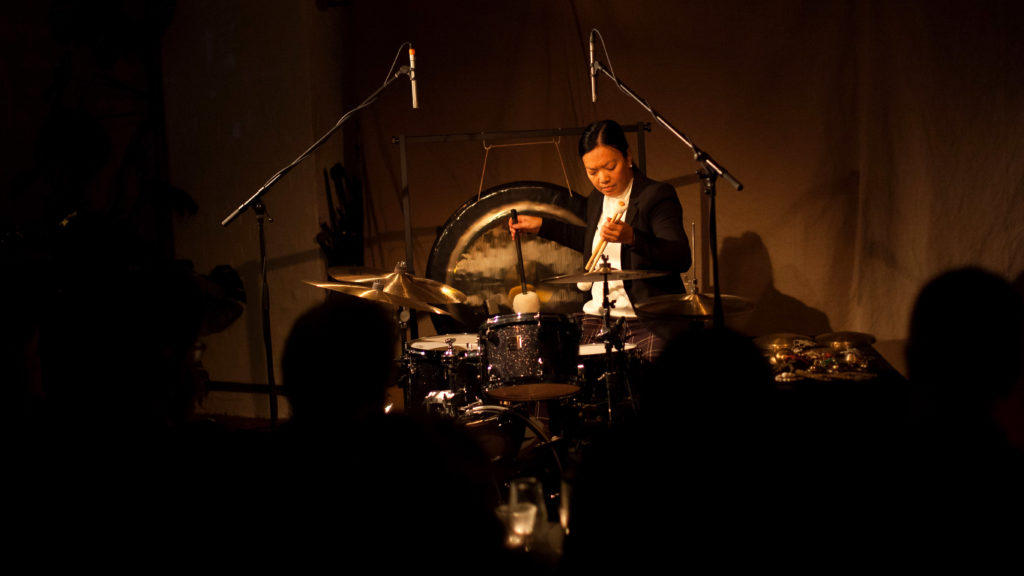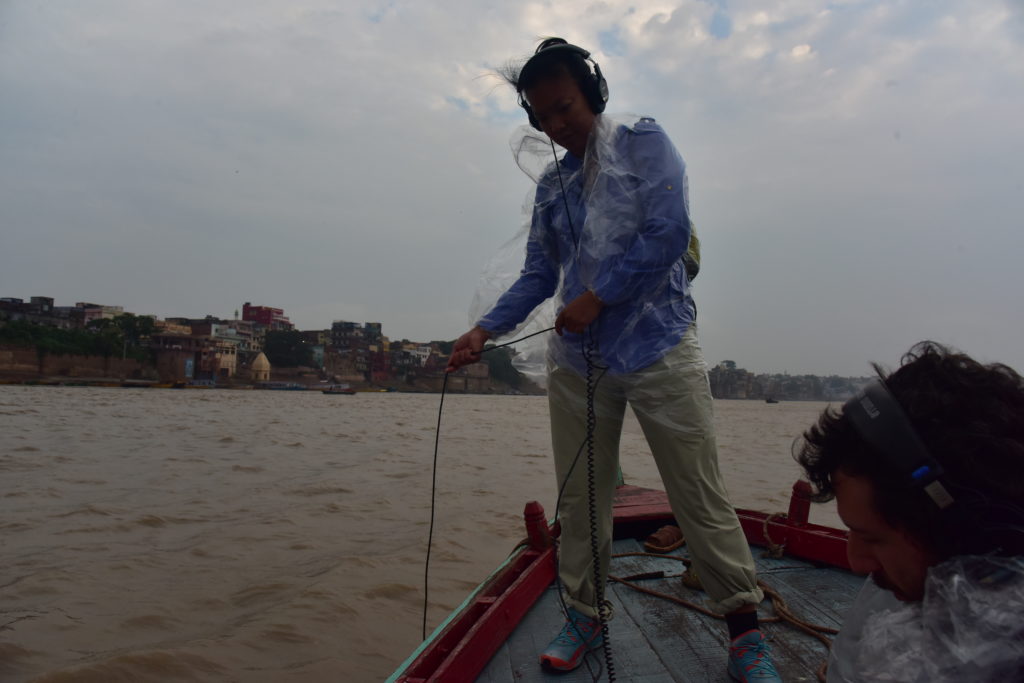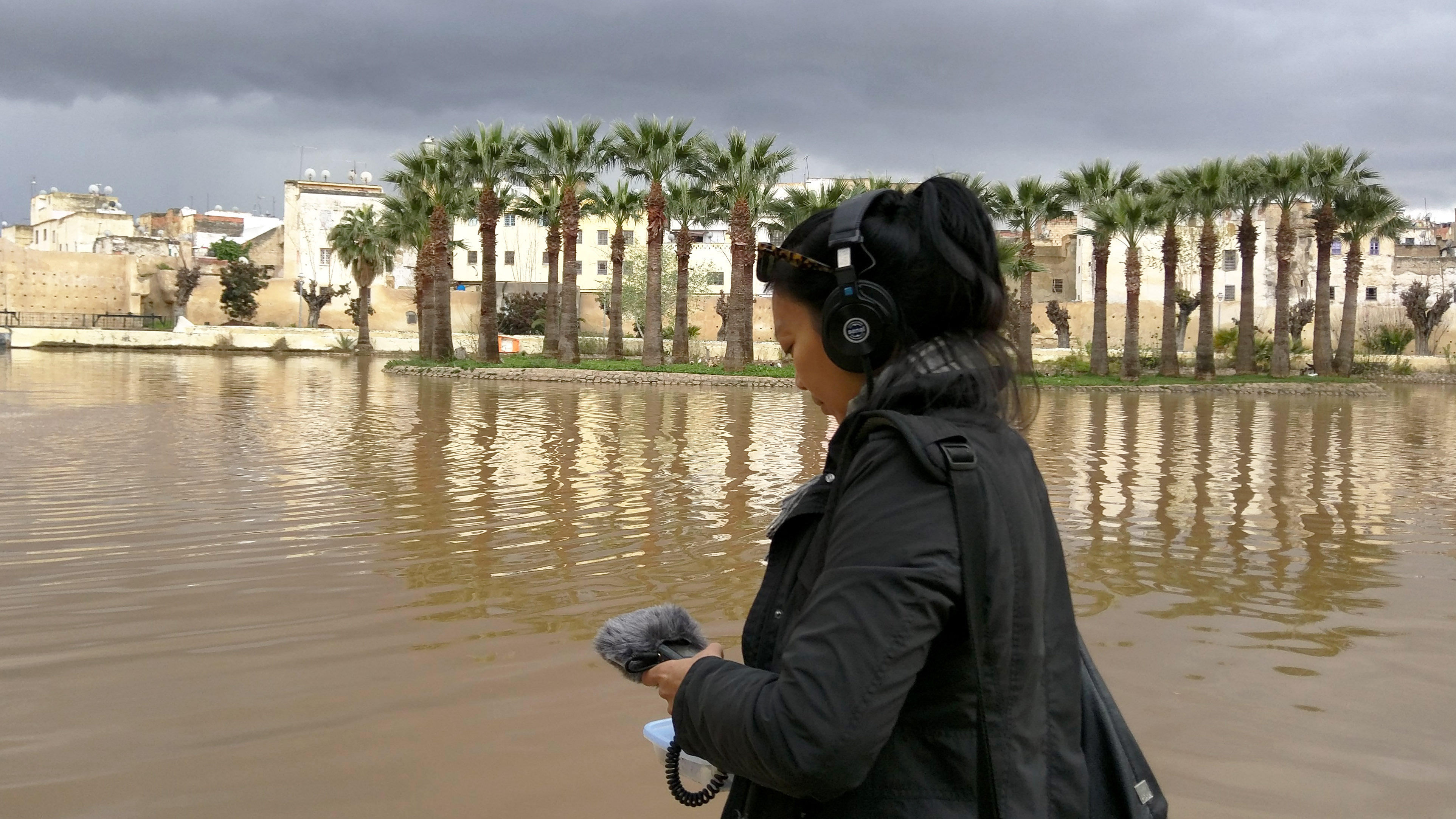Composer, percussionist, and sound artist Susie Ibarra is standing in the medina of Fez, Morocco surrounded by several members of the Fez Hamadacha Sufi Brotherhood. The men are singing and clapping out a sonorous ritual song. Ibarra is holding an audio recorder, head bobbing in approval and in reflex, eyes trained on the device to make sure it is recording at the perfect register.
Ibarra is conducting one of her signature sonic mappings, a series of field recordings that capture the texture, story, and architecture of a place in sound. In collaboration with architect Aziza Chaouni, she is gathering audio footage along the route of the cemented-over Old City river. The waterway is being reopened to create a new water supply for homes and businesses, and the mapping aims to capture the transition. Back in her studio, Ibarra will mix her original score with recordings of water, ambient noise, and traditional musicians at seven historic places along the river to create a sound mapping of urban renewal.

These field recordings are only one element of Ibarra’s widely diverse artistic practice, which she discussed and performed at the Graduate School of Design on November 19, 2019. Ibarra juggles teaching percussion, performance, improvisation, and art intervention at Bennington College with a vibrant career composing, performing, and producing live and recorded musical experiences. Her challenging, multidisciplinary, and often collaborative work has earned Ibarra fellowships and grants with TED, the Asian Cultural Council, the Rockefeller Foundation, and others.
There is the surround-sound installation at a lighthouse in New York engineered with a sound design team to give visitors the impression of being close to a gushing river. There are traditional trio performances with flute and piano; and the “gaming” performance piece where Ibarra and other musicians play a composition that is part scored and part improvisation—and the audience conducts the ensemble. There is the experimental collaboration with a dancer whose movements are synced with motion capture technology to play a specific sound at each articulation. There are traditional Philippine musical scores recomposed for nontraditional instruments and scores for walking tours to musical sanctuaries in North Pittsburgh and lower Manhattan.
So many popular songs sit at a rhythmic sweet spot, across genres of music. There are so many things that are written and recorded in that tempo, and that’s because it is the natural tempo. We might think we’re very disconnected from nature, but it’s just so much larger than we could imagine.
on the parallels between human and non-human rhythm
One of Ibarra’s most ambitious sound mappings is An Acoustic Story on Climate Change: Himalayan Glacier Soundscapes. Working with glaciologist and geomorphologist Michele Koppes, she is recording the Himalayan glacial runoff that feeds into the Ganges, which is increasing as the Earth’s surface temperature rises. “This is an environmental piece and also a storytelling piece about the Himalayan Ganga Basin and how it’s changing,” she says. “The water in the Himalayas is a source for farms and communities of over two billion people. That was one of the reasons we were so interested in the area, also culturally and musically, because it affects so many people.”
After plunging a hydrophone into the rapids at various points along the 1,600-mile-long river, Ibarra will feed the footage into Pro Tools software for cutting, mixing, and editing to produce a recorded memory of climate change. She will showcase the final product in 2020 as a music composition, 3D installation, and performance at the Rubin Museum in New York.

You will recognize common denominators across Ibarra’s projects. First, her unique approach to music making, which is genre-less (Jazz? New age? World?) and highly anthropological. Through sound and rhythm, she explores human society and culture: physical movement, our effect on the natural environment, the energy of architectured spaces and cities, the cultural and ritual memory of a people. “My spatial work looks at how, when we walk into a space or certain environment, we orient ourselves. How we interact and how that also affects our behavior and how we live and conduct ourselves in built environments and in the outdoors,” she explains.
The second unifier is the beat. “As I prepare these sonic installations, people always ask, ‘What ties all of this together?’ and I say, ‘It’s the rhythm.’” And here too, Ibarra’s creative inclinations gravitate toward the overlaps and dialogue between the man-made and the natural. For example, while recording the Ganges, she was tracking the tempo of the torrent (“Mother Nature has serious rhythm,” she says). It occurred to her that it fell within a distinct range—between 100 and 130 beats per minute, the same range that a lot of popular music falls into.
“I realized that there’s a reason why we have so many popular songs that sit at this rhythmic sweet spot, across genres of music. There are so many things that are written and recorded in that tempo and that’s because it is the natural tempo. We might think we’re very disconnected from nature, but it’s just so much larger than we could imagine.”
Ibarra holds a diploma from Mannes College of Music and a B.A. in Music from Goddard College, but before that she was on a different path. When she moved to New York in the late 1980s, her main ambition was to study language and visual arts at Sarah Lawrence. But she brought her drums along. Eventually, galvanized by the vibrant landscape of live music in New York, music “just took over.”
That yielding to instinct and to the call of her environs still serves her professionally and may be partly why her work feels so urgent, honest, and of-the-moment. “I am very sensitive to the energies of a place, and it’s something I’ve accepted and utilized in my artistic practice. But I don’t think I’m the only person; I think we are all sensitive to rhythmic vibrations, whether we choose to take them in or not.”
